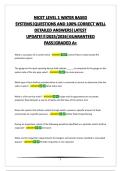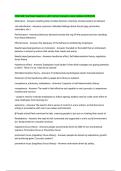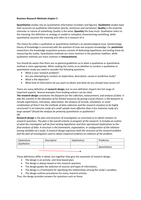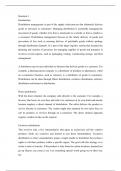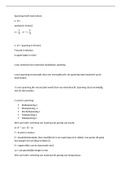Sociological theory 4: structure and culture
Week 1: Introduction
Swidler, A., 1995. Cultural power and Social Movements, in: Klandermans, B.,
Johnston, H. (Eds.), Social Movements and Culture. University of Minneapolis Press,
Minneapolis, pp. 25–41. (14pp)
- In this text the basic theoretical approaches in the sociology of culture are reviewed
and go on to suggest that traditional Weberian approaches, which focus on powerful,
internalized beliefs and values held by individual actors may ultimately provide less
explanatory leverage than newer approaches that see culture are operating in the
context that surround individuals, influencing action from the ‘outside in’.
- The sociology of culture contains two basic traditions:
1. Max weber
Focused on meaningful action
Unit of analysis was the individual
Ideas are developed and promoted by self-interested actors (rulers seeking
to legitimate their rule, elites attempting to justify their privileges, religious
entrepreneurs seeking followers) come to have an independent influence on
social action
Culture shapes action by defining what people want and how they imagine
they can get it. Therefore, it focuses on the complex systems of ideas that
shape individuals’ motives for action
2. Emile Durkheim
Culture is constituted by ‘collective representations’ these are not ideas
(Weberian sense)
Collective representations may range from the vivid totemic symbol to
moral beliefs to modern society’s commitment to reason and individual
autonomy
These representations are not formed out of self-interest, but they are the
vehicles of a fundamental process in which publicly shared symbols
constitute (= be a part of a whole, vormen of uitmaken) social groups while
they constrain and give form to individual consciousness
Symbols collective consciousness animating power of group life
palpable (= so intense as to seem almost tangible) for its members
Therefore, symbols do not reflect group life, but they constitute it
- Talcott Parsons made an attempt in combining Weber and Durkheim’s take on culture,
where he takes the image of action as guided by culturally determined ends and the
notion of culture as a shared, collective product
- Result: Parsonian theory of ‘values’
Values = collectively shared ultimate ends of action
Norms = shared cultural rules that define appropriate means to attain valued
ends
Parsons sees shared values as defining societies, making them what they are
Durkheim’s totem as constituting the Aboriginal clan, making it a society
At the same time, Parsons sees values as governing action Weber’s way of
seeing ideas as switchmen. However, Parsons idea of ‘values’ are in contrast
with Weber’s ideas very general, abstract orientations of action, rather than the
, specific, historically grounded doctrines and worldviews that Weber thought
shaped action
This theory was never really successful
- Geertz is a student of Parsons who argued that culture should be studied for its
meanings and not for its effects on action
- Unit of analysis is publicly available symbols (rituals, aesthetic objects and other
‘texts’)
- If culture influences action, then, it is not by providing the ends people seek, but by
giving them the vocabulary of meanings, the expressive symbols, and the emotional
repertoire with which they can seek anything at all
The revolution in cultural studies
- Three dramatic developments have transformed cultural studies, which can be
summarized as (1) publicness, (2) practices and (3) power
1. Culture as public symbols
Geertz’s work fundamentally redefined the object of cultural analysis (from
individual publicly available symbols)
‘What does this cultural text, ritual, or practice mean to the people who
use, perform, or live it?’
The study of culture could now be grounded in accessible public objects
There is no discussion whether culture is necessarily shared or consensual;
public symbols are clearly shared by the people who use them or form
around the, and the question of whether these symbols’ wider context of
meaning is really shared seem unimportant
Historical meaning is also less important when looking at the meaning of
symbols (Weberian). Contemporary culture analysts trace shifts in
‘discourses’ the larger contexts of meanings within which any particular
ideas or interests can be formulated
2. Practices
Cultural analysts have externalized the locus of culture in another way, by
moving it from the mind’s interior (ideas and mental representations) to
social practices
Revision: Marxian model as ‘superstructure’ efforts of Bourdieu and
Foucault to locate culture in embodied and institutional practices
The concept of practice(s) differs from older conceptions of culture in two
important ways: 1) it emphasizes human agency, for example Bourdieu’s
habitus (deeply internalized habits, styles and skills) that allow human
beings to continually produce innovative actions that are nonetheless
meaningful to others around them, they recreate culture by using culturally
encoded skills to seek strategic advantage AND 2) connection to the study
of institutions, where Foucault analyses how systems of categories and
distinctions are enacted and made real in institutional practices, for
example the differentiation between the sane and the mad, e.g. asylums, are
sets of cultural rules made real by being used to categorize and control
human beings institutions using power to enact rules that construct
human beings
3. Power
Contemporary theorists see culture as itself a form of power
, For example, Foucault thinks of power itself as practices that deploy
knowledge to constitute human beings as the subjects of that knowledge
For example, Bourdieu show how actors use culture in creative ways to
forward their own interests in a system of unequal power, but the effect of
that struggle is to reproduce the basic structure of the system
Culture and social movements
- On the one hand, culture has always been central to the kinds of processes social
movements researchers study (e.g. formulating grievances, defining a common
identity or developing solidarity and mobilizing action), since social movements are
the sites where new cultural resources are most frequently formulated
- On the other hand, the traditional concern of social movement theory with activists
and their motives fits naturally with the Weberian focus on how individuals develop
understandings that guide their action try to understand actors’ experience and the
larger forces that shape their motives, ideas and identities
- It is important that social movement researchers not become wedded to an implicitly
Weberian image of culture just as cultural theory is moving in the other direction –
toward more global, impersonal, institutional, and discursive assertions of cultural
power
Turning culture inside out
- Most culture theory assumes that culture has more powerful effects when its deeper,
BUT some of the time it can have a more powerful effect when its ‘on the outside’
- Variations in the ways social contexts bring culture to bear on action may do more to
determine culture’s power than variations in how deeply culture is held therefore, a
study of these social contexts may prove a fruitful direction for integrating culture into
social movement research
- To analyse culture’s power to affect action, independent of whether it is deeply held,
we may focus on three sources of cultural power: 1) codes, 2) context and 3)
- institutions
- In each case we will see how the culture’s effects on action can operate from the
outside in, as social processes organize and focus culture’s effects on action
Codes
- Culture is seen as a semiotic code, which are usually referred to as deeply held codes.
HOWEVER, some codes are not deep and not visible
- It’s about knowledge of what meanings actions have, principles, signals
Contexts
Institutions
Conclusion
- There are four suggestions done about how culture might be conceived as a global,
collective property without becoming only a diffused mist within which social action
occurs
1. Culture’s power is independent of whether of not people believe in it
2. Culture can have power influence if it shaped not individuals’ own beliefs and
aspirations, but their knowledge of how others will interpret their actions
3. Students of culture and social movements scholars need to pay close attention to
the public contexts in which cultural understandings are brought to bear there is
Week 1: Introduction
Swidler, A., 1995. Cultural power and Social Movements, in: Klandermans, B.,
Johnston, H. (Eds.), Social Movements and Culture. University of Minneapolis Press,
Minneapolis, pp. 25–41. (14pp)
- In this text the basic theoretical approaches in the sociology of culture are reviewed
and go on to suggest that traditional Weberian approaches, which focus on powerful,
internalized beliefs and values held by individual actors may ultimately provide less
explanatory leverage than newer approaches that see culture are operating in the
context that surround individuals, influencing action from the ‘outside in’.
- The sociology of culture contains two basic traditions:
1. Max weber
Focused on meaningful action
Unit of analysis was the individual
Ideas are developed and promoted by self-interested actors (rulers seeking
to legitimate their rule, elites attempting to justify their privileges, religious
entrepreneurs seeking followers) come to have an independent influence on
social action
Culture shapes action by defining what people want and how they imagine
they can get it. Therefore, it focuses on the complex systems of ideas that
shape individuals’ motives for action
2. Emile Durkheim
Culture is constituted by ‘collective representations’ these are not ideas
(Weberian sense)
Collective representations may range from the vivid totemic symbol to
moral beliefs to modern society’s commitment to reason and individual
autonomy
These representations are not formed out of self-interest, but they are the
vehicles of a fundamental process in which publicly shared symbols
constitute (= be a part of a whole, vormen of uitmaken) social groups while
they constrain and give form to individual consciousness
Symbols collective consciousness animating power of group life
palpable (= so intense as to seem almost tangible) for its members
Therefore, symbols do not reflect group life, but they constitute it
- Talcott Parsons made an attempt in combining Weber and Durkheim’s take on culture,
where he takes the image of action as guided by culturally determined ends and the
notion of culture as a shared, collective product
- Result: Parsonian theory of ‘values’
Values = collectively shared ultimate ends of action
Norms = shared cultural rules that define appropriate means to attain valued
ends
Parsons sees shared values as defining societies, making them what they are
Durkheim’s totem as constituting the Aboriginal clan, making it a society
At the same time, Parsons sees values as governing action Weber’s way of
seeing ideas as switchmen. However, Parsons idea of ‘values’ are in contrast
with Weber’s ideas very general, abstract orientations of action, rather than the
, specific, historically grounded doctrines and worldviews that Weber thought
shaped action
This theory was never really successful
- Geertz is a student of Parsons who argued that culture should be studied for its
meanings and not for its effects on action
- Unit of analysis is publicly available symbols (rituals, aesthetic objects and other
‘texts’)
- If culture influences action, then, it is not by providing the ends people seek, but by
giving them the vocabulary of meanings, the expressive symbols, and the emotional
repertoire with which they can seek anything at all
The revolution in cultural studies
- Three dramatic developments have transformed cultural studies, which can be
summarized as (1) publicness, (2) practices and (3) power
1. Culture as public symbols
Geertz’s work fundamentally redefined the object of cultural analysis (from
individual publicly available symbols)
‘What does this cultural text, ritual, or practice mean to the people who
use, perform, or live it?’
The study of culture could now be grounded in accessible public objects
There is no discussion whether culture is necessarily shared or consensual;
public symbols are clearly shared by the people who use them or form
around the, and the question of whether these symbols’ wider context of
meaning is really shared seem unimportant
Historical meaning is also less important when looking at the meaning of
symbols (Weberian). Contemporary culture analysts trace shifts in
‘discourses’ the larger contexts of meanings within which any particular
ideas or interests can be formulated
2. Practices
Cultural analysts have externalized the locus of culture in another way, by
moving it from the mind’s interior (ideas and mental representations) to
social practices
Revision: Marxian model as ‘superstructure’ efforts of Bourdieu and
Foucault to locate culture in embodied and institutional practices
The concept of practice(s) differs from older conceptions of culture in two
important ways: 1) it emphasizes human agency, for example Bourdieu’s
habitus (deeply internalized habits, styles and skills) that allow human
beings to continually produce innovative actions that are nonetheless
meaningful to others around them, they recreate culture by using culturally
encoded skills to seek strategic advantage AND 2) connection to the study
of institutions, where Foucault analyses how systems of categories and
distinctions are enacted and made real in institutional practices, for
example the differentiation between the sane and the mad, e.g. asylums, are
sets of cultural rules made real by being used to categorize and control
human beings institutions using power to enact rules that construct
human beings
3. Power
Contemporary theorists see culture as itself a form of power
, For example, Foucault thinks of power itself as practices that deploy
knowledge to constitute human beings as the subjects of that knowledge
For example, Bourdieu show how actors use culture in creative ways to
forward their own interests in a system of unequal power, but the effect of
that struggle is to reproduce the basic structure of the system
Culture and social movements
- On the one hand, culture has always been central to the kinds of processes social
movements researchers study (e.g. formulating grievances, defining a common
identity or developing solidarity and mobilizing action), since social movements are
the sites where new cultural resources are most frequently formulated
- On the other hand, the traditional concern of social movement theory with activists
and their motives fits naturally with the Weberian focus on how individuals develop
understandings that guide their action try to understand actors’ experience and the
larger forces that shape their motives, ideas and identities
- It is important that social movement researchers not become wedded to an implicitly
Weberian image of culture just as cultural theory is moving in the other direction –
toward more global, impersonal, institutional, and discursive assertions of cultural
power
Turning culture inside out
- Most culture theory assumes that culture has more powerful effects when its deeper,
BUT some of the time it can have a more powerful effect when its ‘on the outside’
- Variations in the ways social contexts bring culture to bear on action may do more to
determine culture’s power than variations in how deeply culture is held therefore, a
study of these social contexts may prove a fruitful direction for integrating culture into
social movement research
- To analyse culture’s power to affect action, independent of whether it is deeply held,
we may focus on three sources of cultural power: 1) codes, 2) context and 3)
- institutions
- In each case we will see how the culture’s effects on action can operate from the
outside in, as social processes organize and focus culture’s effects on action
Codes
- Culture is seen as a semiotic code, which are usually referred to as deeply held codes.
HOWEVER, some codes are not deep and not visible
- It’s about knowledge of what meanings actions have, principles, signals
Contexts
Institutions
Conclusion
- There are four suggestions done about how culture might be conceived as a global,
collective property without becoming only a diffused mist within which social action
occurs
1. Culture’s power is independent of whether of not people believe in it
2. Culture can have power influence if it shaped not individuals’ own beliefs and
aspirations, but their knowledge of how others will interpret their actions
3. Students of culture and social movements scholars need to pay close attention to
the public contexts in which cultural understandings are brought to bear there is



